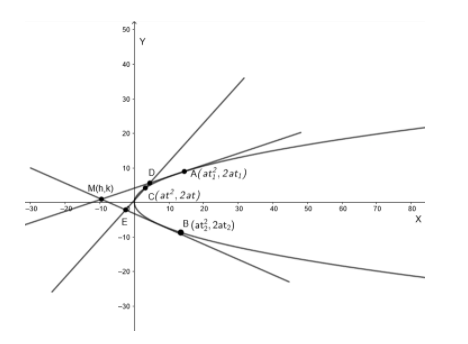
Two tangents to a parabola intercept on a fixed tangent segment whose product is a constant. Prove that the locus of their point of intersection is a straight line.
Answer
531.9k+ views
Hint: The general equation of tangent at
The point of intersection of tangents at
We will consider the equation of the parabola to be
We will consider two points

Now , we will find the equation of tangents at these points.
Now, we know the general equation of tangent at
So , the equation of tangent at
On substituting
And equation of tangent at
Now, we need to find the locus of the point of intersection of
Let the point of intersection be
Now, from equation
We will substitute the value of
On substituting value of
Substituting
So, the point of intersection of tangents
Comparing it with
And
Now, we will consider the point of contact of the fixed tangent be
So , the point of intersection of tangent at
And the point of intersection of tangent at
Now, in the question it is given that the product of intercept on the fixed tangent is constant.
So,
Substituting
Now, to find the locus of
So , the locus of
Note: : While simplifying the equations , please make sure that sign mistakes do not occur. These mistakes are very common and can cause confusions while solving. Ultimately the answer becomes wrong. So, sign conventions should be carefully taken .
The point of intersection of tangents at
We will consider the equation of the parabola to be
We will consider two points

Now , we will find the equation of tangents at these points.
Now, we know the general equation of tangent at
So , the equation of tangent at
On substituting
And equation of tangent at
Now, we need to find the locus of the point of intersection of
Let the point of intersection be
Now, from equation
We will substitute the value of
On substituting value of
Substituting
So, the point of intersection of tangents
Comparing it with
And
Now, we will consider the point of contact of the fixed tangent be
So , the point of intersection of tangent at
And the point of intersection of tangent at
Now, in the question it is given that the product of intercept on the fixed tangent is constant.
So,
Substituting
Now, to find the locus of
So , the locus of
Note: : While simplifying the equations , please make sure that sign mistakes do not occur. These mistakes are very common and can cause confusions while solving. Ultimately the answer becomes wrong. So, sign conventions should be carefully taken .
Latest Vedantu courses for you
Grade 10 | CBSE | SCHOOL | English
Vedantu 10 CBSE Pro Course - (2025-26)
School Full course for CBSE students
₹37,300 per year
Recently Updated Pages
Master Class 4 Maths: Engaging Questions & Answers for Success

Master Class 4 English: Engaging Questions & Answers for Success

Master Class 4 Science: Engaging Questions & Answers for Success

Class 4 Question and Answer - Your Ultimate Solutions Guide

Master Class 11 Economics: Engaging Questions & Answers for Success

Master Class 11 Business Studies: Engaging Questions & Answers for Success

Trending doubts
Give 10 examples of unisexual and bisexual flowers

Draw a labelled sketch of the human eye class 12 physics CBSE

Differentiate between homogeneous and heterogeneous class 12 chemistry CBSE

a Tabulate the differences in the characteristics of class 12 chemistry CBSE

Why is the cell called the structural and functional class 12 biology CBSE

Differentiate between insitu conservation and exsitu class 12 biology CBSE




